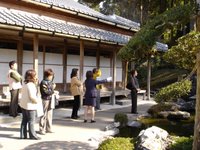Japan: Hiroshima 35 - Interesting tidbits of society
There are good things about women and society in Japan. However, this one is a summary of the appalling things I have learned based from my discussions with other Japanese women and foreigners, reading articles and my own observations...
Japanese culture from old to new:
Back in the day, the typical Japanese woman will quit working when she gets married. She then becomes a stay at home wife and mom. And as custom goes, if a woman marries the oldest son in his family, she not only takes care of her kids, but also her husband's elderly parents. (My Japanese teacher said when she was young, she would avoid dating guys who were the oldest son). As times have changed, many Japanese women want a career instead. They work hard to get into a good University, secure good jobs and often do not get married until much, much later, if at all. Japan's population has been on a steady decline. There are more death rates than birth rates and they're working population is aging. The cost of raising a child is sky high and with no day care availability, more women are choosing career over children. (Many of the few day cares that do exist are unlicensed.) Still tradition prevails over many households and sometimes it is the husband or even the woman's manager at work, who wants her to stay home and be a housewife. Those that are becoming more modern realize the importance of having dual income in a high cost society, and may forgo having children.
Dishwasher and Dishdryer:
In many of our friends' apartments, we notice dishwashers that are super super tiny (like the kind you have in a dorm room), even if there is room for a larger one. In some, there are huge dishdryers but no dishwasher. I have learned that this is intentional so that the wife does not get lazy. (WTF!)
Affairs:
For such a rigid country w/many rules, affairs are not uncommon. It is not unusual for the husband's company to send him elsewhere to work, while the wife and kids stay. The reason is because of the school system. They kids have to stay where they have access to top schools so they get into top Universities. Sometimes husband and wife are apart for many, many years until the children graduate high school or even college. Therefore there are husbands who have girlfriends elsewhere or they frequent bar hostesses.
Bar Hostesses: Bar hostesses are expensive companions for the evening. They lavish attention on men while they expertly suck them dry of their money. Here is an excerpt from Japan Times: Kyabakura -- budget-priced drinking establishments that charge a flat hourly rate to sit and drink with young hostesses -- are popular with rank-and-file salarymen. But a growing number of salaried workers have been discovering to their chagrin that kyabakura can be an ruinously expensive habit...men visit clubs where they can relax over a drink, and entertain the hope they might get lucky and seduce a sweet young thing. A 24-year-old retail store employee relates his own tale of woe. "Although my monthly take-home pay was only about 180,000 yen, I began visiting a club in Ikebukuro where this really nice girl worked. I wound up going four nights a week, with the bills more than 20,000 yen each time. Within a year, I'd spent over 2 million yen and was flat broke. I had no choice but to file for personal bankruptcy."
Alibi Channel:
There is a radio channel that exists for the sole purpose of giving your wife an alibi. For example, you can call your wife from your cell phone and the channel plays background sounds for say, traffic. Then you can tell your wife you are stuck in traffic. (how awful!)
Autoshow outfits: The skimpy outfits that models wear at autoshows can be bought in autoshow magazines. Pick from an array of mesh, short skirts, or small tops and they can be yours so you too can be a car model and show off your boyfriend's car...NOT!




















